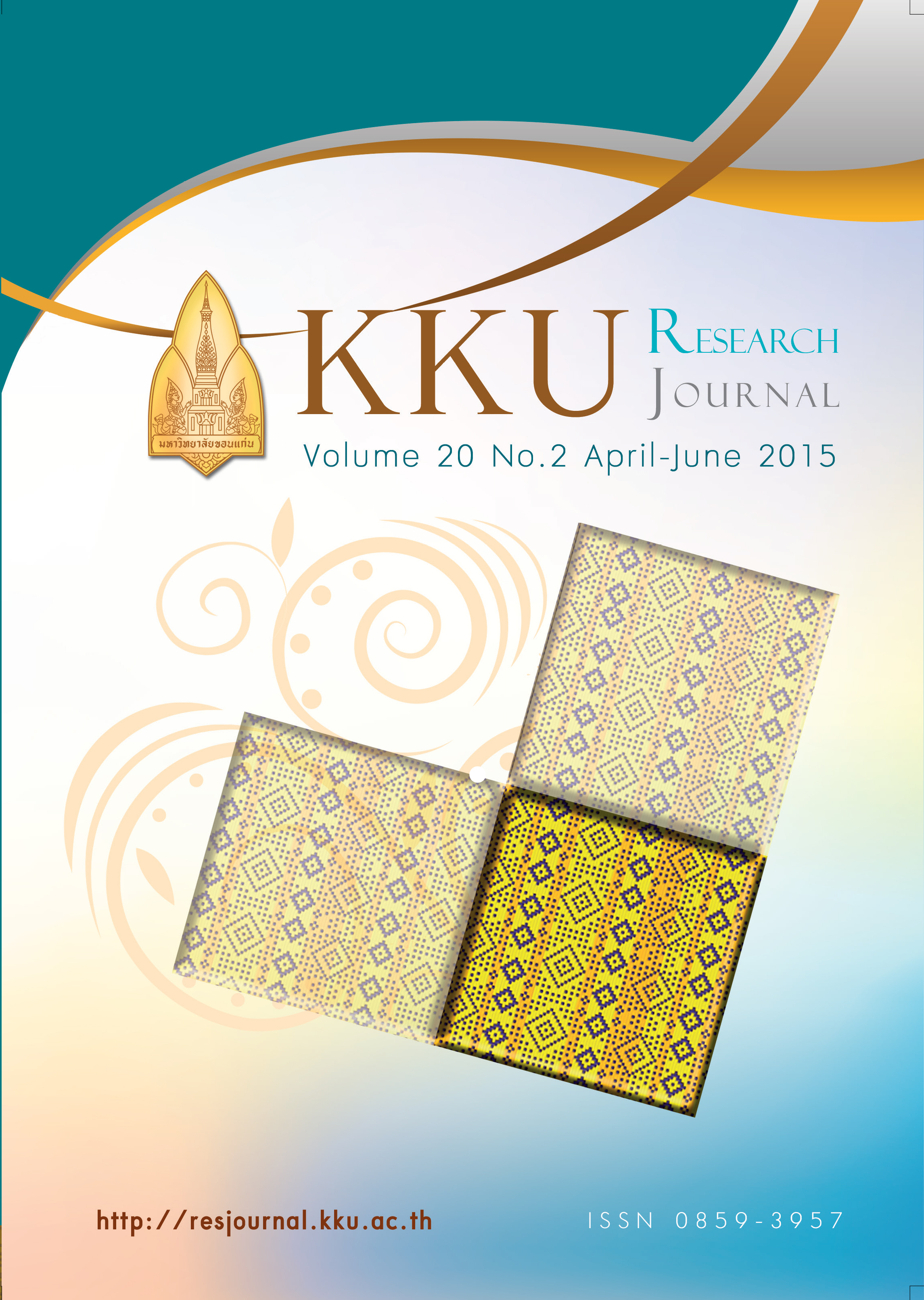Application of GIS-based curve number method for runoff estimation in agricultural-forest watershed, Thailand
Main Article Content
Abstract
The objective of this study was to apply the GIS-based hydrologic model for simulating runoff in the Upper Lam Ta Kong watershed, an agricultural-forest watershed, Nakhon Ratchasima province, Thailand. The Soil Conservation Service Curve Number (SCS-CN) method integrated with a Geographic Information System (GIS) was used to simulate the event-based runoff. Model calibration and validation were performed by comparing observed and simulated results at the M.43A and M.89 stations during the monsoon season of year 2011 and 2012, respectively. The runoff model calibration showed that the coefficient of efficiency (E) was 0.74 and coefficient of determination (R2) was 0.83 at the M.43A while E was 0.73 and R2 was 0.78 at the M.89 station. The results of the runoff model validation showed that the E was 0.66 and R2 was 0.75 at the M.43A while E was 0.73 and R2 was 0.87 at the M.89 station. This indicated that the GIS-based curve number method could be applied with satisfactory accuracy to runoff estimation in the study area. This model was also able to estimate varying runoff over the watershed spatially.
Article Details
References
[2] Olivera F, Maidment D. Geographic information system (GIS)-based spatially distributed model for runoff routing. Water Resour. Res. 1999; 35(4): 1155-1164.
[3] Pullar D, Springer D. Towards integrating GIS and catchment models. Environ. Modell. Softw. 2000; 15(5): 451-459.
[4] Shen C, Niu J, Phannikumar MS. Evaluating controls on coupled hydrologic and vegetation dynamics in a humid continental climate watershed using a subsurface-land surface processes model. Water Resour. Res. 2013; 49: 2552-2572.
[5] Lecca G, Petitdidier M, Hluchy L, Ivanovic M, Kussul N, Ray N, Thieron V. Grid computing technology for hydrological applications. J. Hydrol. 2011; 402(1-2): 186-199.
[6] Kang K, Merwade V. Development and application of a storage-release based distributed hydrologic model using GIS. J. Hydrol. 2011; 403(1-2): 1-13.
[7] Sharma T, Satya Kiran PV, Singh TP, Trivedi AV. Navalgund, R.R. Hydrological response of watershed to Landuse changes: Remote sensing and GIS approach. Int. J. Remote. Sens. 2001; 22: 2095-2108.
[8] Sirijungsakul S. A monthly rainfall-runoff model [MSc Thesis]. Bangkok: Chulalongkorn University; 1995. Thai.
[9] Disayaman C. An application of SCS principle for estimating monthly runoff from Thailand watersheds [MSc Thesis]. Khon Kaen: Khon Kaen University; 1995. Thai.
[10] Guzmán RH, Luna AR, Robles CAB. CN-Idris: An Idrisi tool for generating curve number maps and estimating direct runoff. Environ. Modell. Softw. 2011; 26(12): 1764-1766.
[11] El-Hames AS. An empirical method for peak discharge prediction in ungauged arid and semi-arid region catchments based on morphological parameters and SCS curve number. J. Hydrol. 2012; 456-457:94-100.
[12] Patil JP, Sarangi A, Singh AK, Ahmad T. Evaluation of modified CN methods for watershed runoff estimation using a GIS-based interface. Biosyst. Eng. 2008; 100(1): 137-146.
[13] Zhan X, Huang ML. ArcCN-Runoff: an ArcGIS tool for gener-ating curve number and runoff maps. Environ. Modell. Softw. 2004; 19(10): 875-879.
[14] Deshmukh DS, Chaube UC, Hailu AE, Gudeta DA, Kassa MT. Estimation and comparision of curve numbers based on dynamic land use land cover change, observed rainfall-runoff data and land slope. J. Hydrol. 2013; 492: 89-101.
[15] Jenson SK, Domingue JO. Extracting topographic structure from digital elevation data for geographic information system analysis. Photogramm. Eng. Remote Sens. 1988; 54(11): 1593-1600.
[16] National Resources Conservation Service (NRCS). Hydrologic soil group: Part 630 hydrology engineering handbook. United States Department of Agriculture, Washington, DC, USA; 2007.
[17] National Resources Conservation Service (NRCS). Estimation of direct runoff from storm rainfall: Part 630 hydrology national engineering handbook. United States Department of Agriculture, Washington, DC, USA; 2004.
[18] Mishra SK, Singh VP. Soil Conser-vation Service Curve Number (SCS-CN) methodology. Kluwer Academic Publishers, Dordrecht, Netherlands; 2003.
[19] Chow VT, Maidment DR, Mays LW. Applied hydrology. McGraw-Hill, New York; 1988.(20) Nash JE, Sutcliffe JV. River flow forecasting through conceptual models. Part I: A discussion of principles. J. Hydrol. 1978; 10: 282-290.


